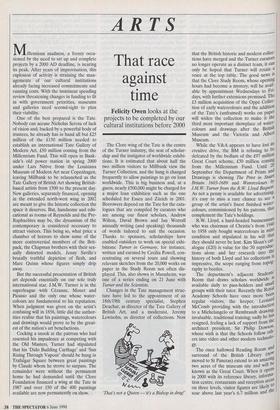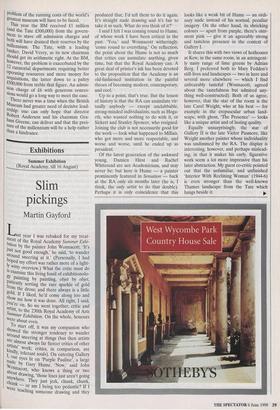ARTS
That race against time
Felicity Owen looks at the projects to be completed by our cultural institutions before 2000
Millennium madness, a frenzy occa- sioned by the need to set up and complete projects by a 2000 AD deadline, is nearing its peak. After years of improvisation, this explosion of activity is straining the man- agements of our cultural institutions already facing increased commitments and running costs. With the imminent spending review threatening changes in funding to fit in with government priorities, museums and galleries need second-sight to plan their viability.
One of the best prepared is the Tate. Nobody can accuse Nicholas Scrota of lack of vision and, backed by a powerful body of trustees, he already has in hand all but £25 million of the £150 million needed to establish an international Tate Gallery of Modern Art, £50 million coming from the Millennium Fund. This will open in Bank- side's old power station in spring 2000 under Lars Nittve from the Louisiana Museum of Modern Art near Copenhagen, leaving Millbank to be relaunched as the Tate Gallery of British Art showing British- based artists from 1500 to the present day. New galleries, separately financed, opening in the extended north-west wing in 2002 are meant to give the historic collection the space it deserves. But, handsome and edu- cational as rooms of Reynolds and the Pre- Raphaelites may be, the dynamism of the contemporary is considered necessary to attract visitors. This being so, what price a chamber of horrors to show some of the more controversial members of the Brit- pack, the Chapman brothers with their sex- ually distorted models, Jenny Saville's brutally truthful depiction of flesh, and Marc Quinn whose figures simply drip away.
But the successful presentation of British art depends essentially on our sole truly international star. J.M.W. Turner is in the superleague with Cezanne, Monet and Picasso and the only one whose water- colours are fundamental to his reputation. When judgment was given on the artist's confusing will in 1856, little did the author- ities realise that his paintings, watercolours and drawings would prove to be the great- est of the nation's art benefactions.
Cocking a snook at the patrons who had resented his impudence at competing with the Old Masters, Turner had stipulated that his Did° Building Carthage' and 'Sun Rising Through Vapour' should be hung in Trafalgar Square between great paintings by Claude whom he strove to surpass. The remainder were without the permanent home he had demanded until the Clore Foundation financed a wing at the Tate in 1987 and over 150 of the 400 paintings available are now permanently on show. The Clore wing of the Tate is the centre of the Turner industry, the seat of scholar- ship and the instigator of worldwide exhibi- tions. It is estimated that about half the two million visitors to Millbank view the Turner Collection, and the hang is changed frequently to allow paintings to go on loan worldwide. This is big business and, at a guess, nearly £500,000 might be charged for a major loan exhibition such as the one scheduled for Essen and Ziirich in 2001. Borrowers depend on the Tate for the cata- logues that are compiled by curators who are among our finest scholars, Andrew Wilton, David Brown and Ian Worrall annually writing (and speaking) thousands of words tailored to suit the occasion. Thanks to sponsors, scholarships have enabled outsiders to work on special exhi- bitions: Turner in Germany, for instance, written and curated by Cecilia Powell, con- centrating on several tours and showing relevant sketches from the 20,000 works on paper in the Study Room not often dis- played. This, also shown in Mannheim, was one of a series ending on 21 June with Turner and the Scientists.
Changes in the Tate management struc- ture have led to the appointment of an 18th/19th century specialist, Stephen Deuchar, as director of the Tate Gallery of British Art, and a modernist, Jeremy Lewisohn, as director of collections. Now 'That's not a Queen — it's a Bishop in drag!'
that the British historic and modern collec- tions have merged and the Turner curators no longer operate as a distinct team, it can only be hoped that Turner will retain a voice at the top table. The good news is that the Clore Study Room, whose opening hours had become a mystery, will be avail- able by appointment Wednesdays to Fri- days, with further extensions promised. The £3 million acquisition of the Oppe tion of early watercolours and the addition of the Tate's (unframed) works on paper will widen the collection to make it the third most important showplace of water- colours and drawings after the British Museum and the Victoria and Albert Museum.
While the V&A appears to have lost its creative drive, the BM is refusing to be defeated by the bedlam of the £97 million Great Court scheme, £30 million coming from the Millennium Fund. Until 20 September the Department of Prints and Drawings is showing The Print in Stuart Britain 1603-1689 and Watercolours by J.M.W. Turner from the R. W. Lloyd Bequest' As not a penny is available for advertising, it's easy to miss a rare chance to see a group of the artist's finest finished water- colours, commissioned by his patrons, that complement the Tate's holdings. R.W. Lloyd, a hard-headed businessman who was chairman of Christie's from 1940 to 1958 only bought watercolours in mint, condition and stipulated in his will dial they should never be lent. Kim Sloan's cat- alogue (£20) is value for the 50 reprodue- tions alone and her research into th,e history of both Lloyd and his collections is impressive, the scope ranging from topog- raphy to beetles. The department's adjacent Students' Room that draws scholars worldwide is available daily to pass-holders and stroll groups with their tutor. Recently the RoYal Academy Schools have once more been regular visitors, the keeper, Leonard McComb providing with the introduction to a Michelangelo or Rembrandt drawing' invaluable, traditional training; sadly he has resigned, feeling a lack of support from the architect president, Sir Philip Dawson, whose wish is that the Schools follow oth- ers into video and other modern technolo- gY. The once hallowed Reading Room and surround of the British Library (n° moved to St Pancras) extend to an amazing two acres of the museum site and will he known as the Great Court. When it opens in 2000 with its reference library, inforrna- tion centre, restaurants and reception areas on three levels, visitor figures are likely KJ soar above last year's 6.7 million and the Problem of the running costs of the world's greatest museum will have to be faced.
This year the BM received 11 million (and the Tate £300,000) from the govern- ment to stave off admission charges and both will have drained their reserves by the nullennium. The Tate, with a leading banker, David Verey, as its new chairman should get its arithmetic right. At the BM, however, the problem is exacerbated by the 12 curatorial departments requiring better operating resources and more money for acquisitions, the latter down to a paltry £5. 00,000 from treble that figure. An admis- S1.0n charge of £6 with generous conces- sions would go a long way to meet the case. There never was a time when the British Museum had greater need of decisive lead- ership: one can only hope that director Robert Anderson and his chairman Gra- ham Greene, can deliver and that the pres- sure of the millennium will be a help rather than a hindrance.



























































 Previous page
Previous page